Importance of Hygienic Environment in Urethral Catheterization | Report
VerifiedAdded on 2022/09/14
|7
|1917
|12
AI Summary
Contribute Materials
Your contribution can guide someone’s learning journey. Share your
documents today.
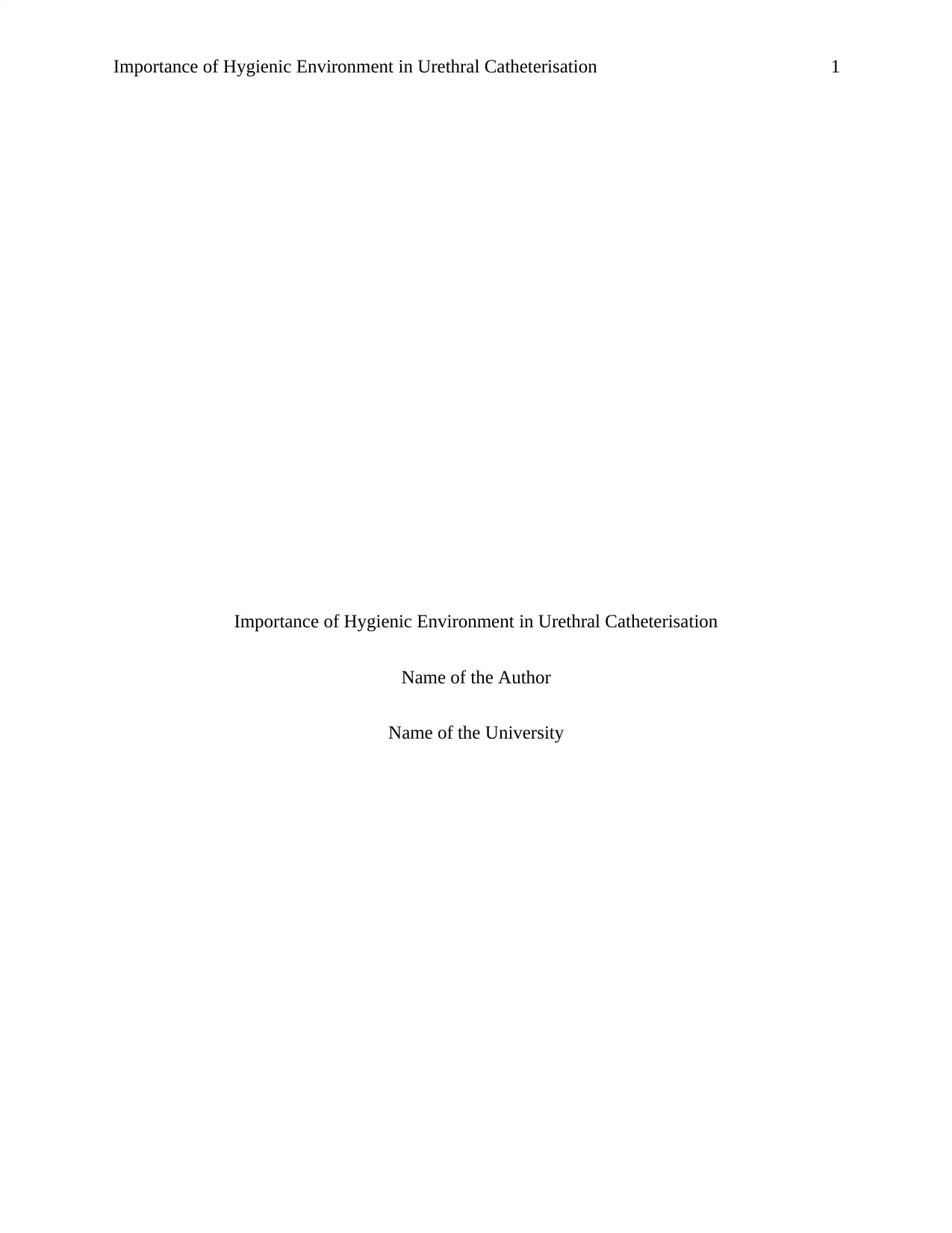
Importance of Hygienic Environment in Urethral Catheterisation 1
Importance of Hygienic Environment in Urethral Catheterisation
Name of the Author
Name of the University
Importance of Hygienic Environment in Urethral Catheterisation
Name of the Author
Name of the University
Secure Best Marks with AI Grader
Need help grading? Try our AI Grader for instant feedback on your assignments.
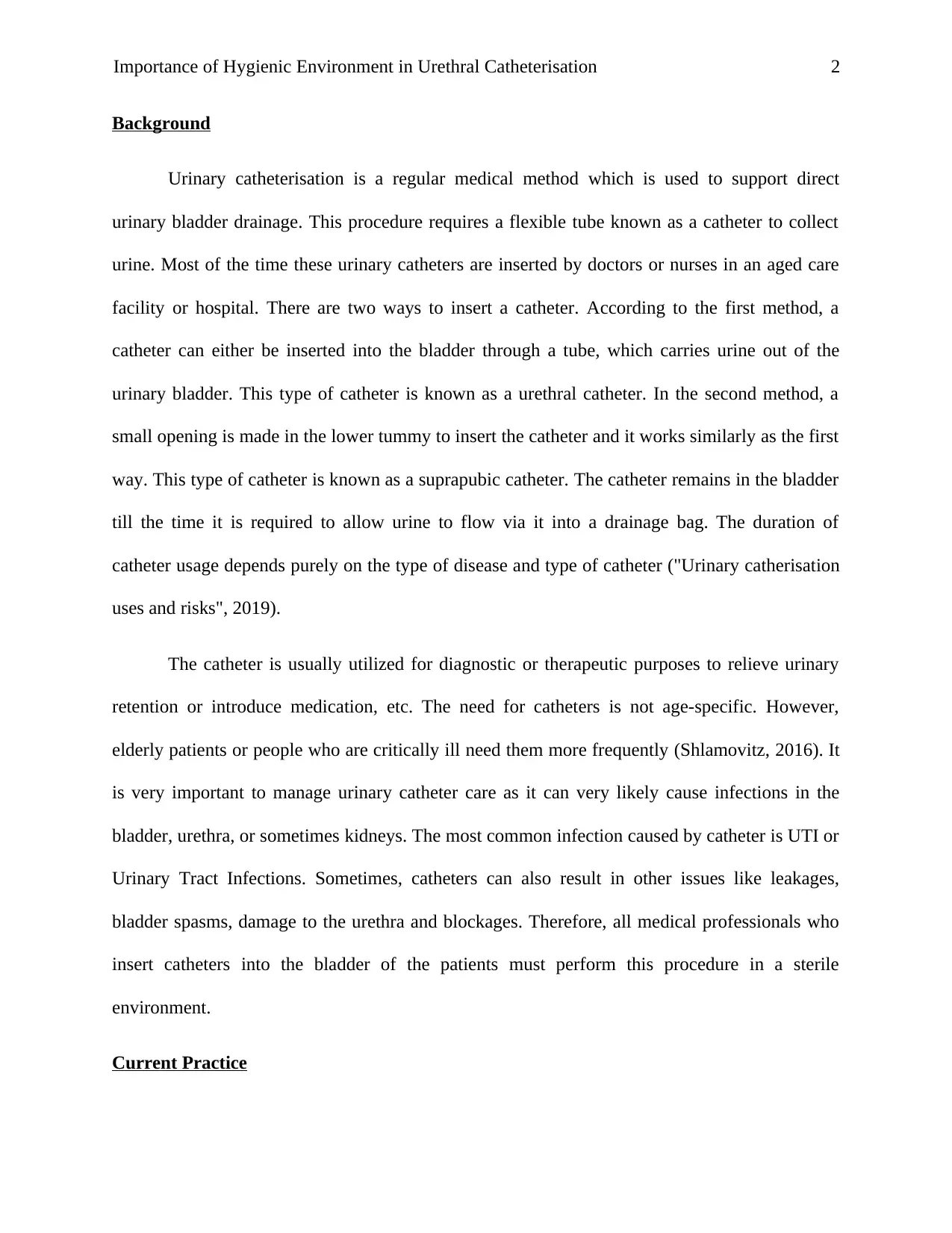
Importance of Hygienic Environment in Urethral Catheterisation 2
Background
Urinary catheterisation is a regular medical method which is used to support direct
urinary bladder drainage. This procedure requires a flexible tube known as a catheter to collect
urine. Most of the time these urinary catheters are inserted by doctors or nurses in an aged care
facility or hospital. There are two ways to insert a catheter. According to the first method, a
catheter can either be inserted into the bladder through a tube, which carries urine out of the
urinary bladder. This type of catheter is known as a urethral catheter. In the second method, a
small opening is made in the lower tummy to insert the catheter and it works similarly as the first
way. This type of catheter is known as a suprapubic catheter. The catheter remains in the bladder
till the time it is required to allow urine to flow via it into a drainage bag. The duration of
catheter usage depends purely on the type of disease and type of catheter ("Urinary catherisation
uses and risks", 2019).
The catheter is usually utilized for diagnostic or therapeutic purposes to relieve urinary
retention or introduce medication, etc. The need for catheters is not age-specific. However,
elderly patients or people who are critically ill need them more frequently (Shlamovitz, 2016). It
is very important to manage urinary catheter care as it can very likely cause infections in the
bladder, urethra, or sometimes kidneys. The most common infection caused by catheter is UTI or
Urinary Tract Infections. Sometimes, catheters can also result in other issues like leakages,
bladder spasms, damage to the urethra and blockages. Therefore, all medical professionals who
insert catheters into the bladder of the patients must perform this procedure in a sterile
environment.
Current Practice
Background
Urinary catheterisation is a regular medical method which is used to support direct
urinary bladder drainage. This procedure requires a flexible tube known as a catheter to collect
urine. Most of the time these urinary catheters are inserted by doctors or nurses in an aged care
facility or hospital. There are two ways to insert a catheter. According to the first method, a
catheter can either be inserted into the bladder through a tube, which carries urine out of the
urinary bladder. This type of catheter is known as a urethral catheter. In the second method, a
small opening is made in the lower tummy to insert the catheter and it works similarly as the first
way. This type of catheter is known as a suprapubic catheter. The catheter remains in the bladder
till the time it is required to allow urine to flow via it into a drainage bag. The duration of
catheter usage depends purely on the type of disease and type of catheter ("Urinary catherisation
uses and risks", 2019).
The catheter is usually utilized for diagnostic or therapeutic purposes to relieve urinary
retention or introduce medication, etc. The need for catheters is not age-specific. However,
elderly patients or people who are critically ill need them more frequently (Shlamovitz, 2016). It
is very important to manage urinary catheter care as it can very likely cause infections in the
bladder, urethra, or sometimes kidneys. The most common infection caused by catheter is UTI or
Urinary Tract Infections. Sometimes, catheters can also result in other issues like leakages,
bladder spasms, damage to the urethra and blockages. Therefore, all medical professionals who
insert catheters into the bladder of the patients must perform this procedure in a sterile
environment.
Current Practice
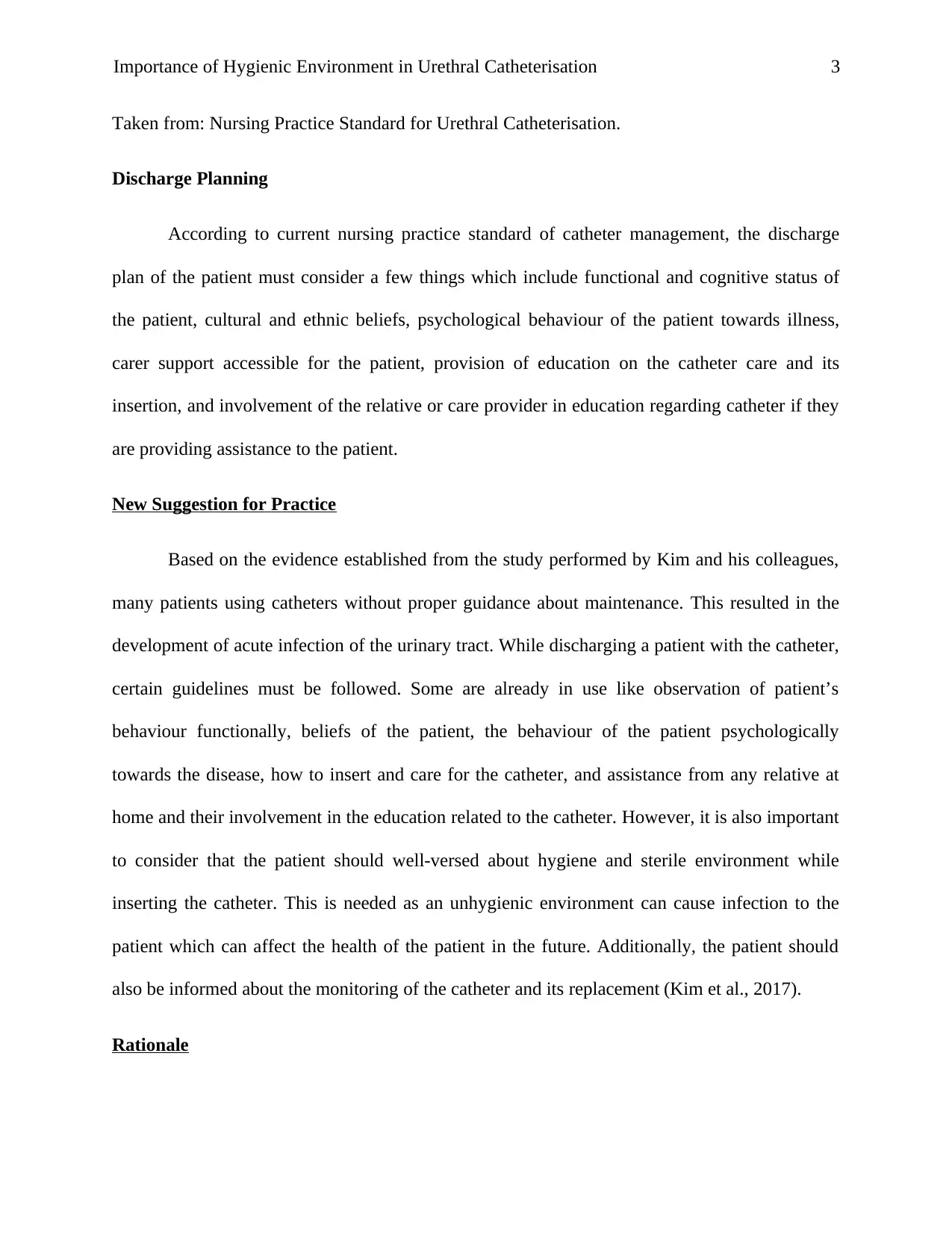
Importance of Hygienic Environment in Urethral Catheterisation 3
Taken from: Nursing Practice Standard for Urethral Catheterisation.
Discharge Planning
According to current nursing practice standard of catheter management, the discharge
plan of the patient must consider a few things which include functional and cognitive status of
the patient, cultural and ethnic beliefs, psychological behaviour of the patient towards illness,
carer support accessible for the patient, provision of education on the catheter care and its
insertion, and involvement of the relative or care provider in education regarding catheter if they
are providing assistance to the patient.
New Suggestion for Practice
Based on the evidence established from the study performed by Kim and his colleagues,
many patients using catheters without proper guidance about maintenance. This resulted in the
development of acute infection of the urinary tract. While discharging a patient with the catheter,
certain guidelines must be followed. Some are already in use like observation of patient’s
behaviour functionally, beliefs of the patient, the behaviour of the patient psychologically
towards the disease, how to insert and care for the catheter, and assistance from any relative at
home and their involvement in the education related to the catheter. However, it is also important
to consider that the patient should well-versed about hygiene and sterile environment while
inserting the catheter. This is needed as an unhygienic environment can cause infection to the
patient which can affect the health of the patient in the future. Additionally, the patient should
also be informed about the monitoring of the catheter and its replacement (Kim et al., 2017).
Rationale
Taken from: Nursing Practice Standard for Urethral Catheterisation.
Discharge Planning
According to current nursing practice standard of catheter management, the discharge
plan of the patient must consider a few things which include functional and cognitive status of
the patient, cultural and ethnic beliefs, psychological behaviour of the patient towards illness,
carer support accessible for the patient, provision of education on the catheter care and its
insertion, and involvement of the relative or care provider in education regarding catheter if they
are providing assistance to the patient.
New Suggestion for Practice
Based on the evidence established from the study performed by Kim and his colleagues,
many patients using catheters without proper guidance about maintenance. This resulted in the
development of acute infection of the urinary tract. While discharging a patient with the catheter,
certain guidelines must be followed. Some are already in use like observation of patient’s
behaviour functionally, beliefs of the patient, the behaviour of the patient psychologically
towards the disease, how to insert and care for the catheter, and assistance from any relative at
home and their involvement in the education related to the catheter. However, it is also important
to consider that the patient should well-versed about hygiene and sterile environment while
inserting the catheter. This is needed as an unhygienic environment can cause infection to the
patient which can affect the health of the patient in the future. Additionally, the patient should
also be informed about the monitoring of the catheter and its replacement (Kim et al., 2017).
Rationale
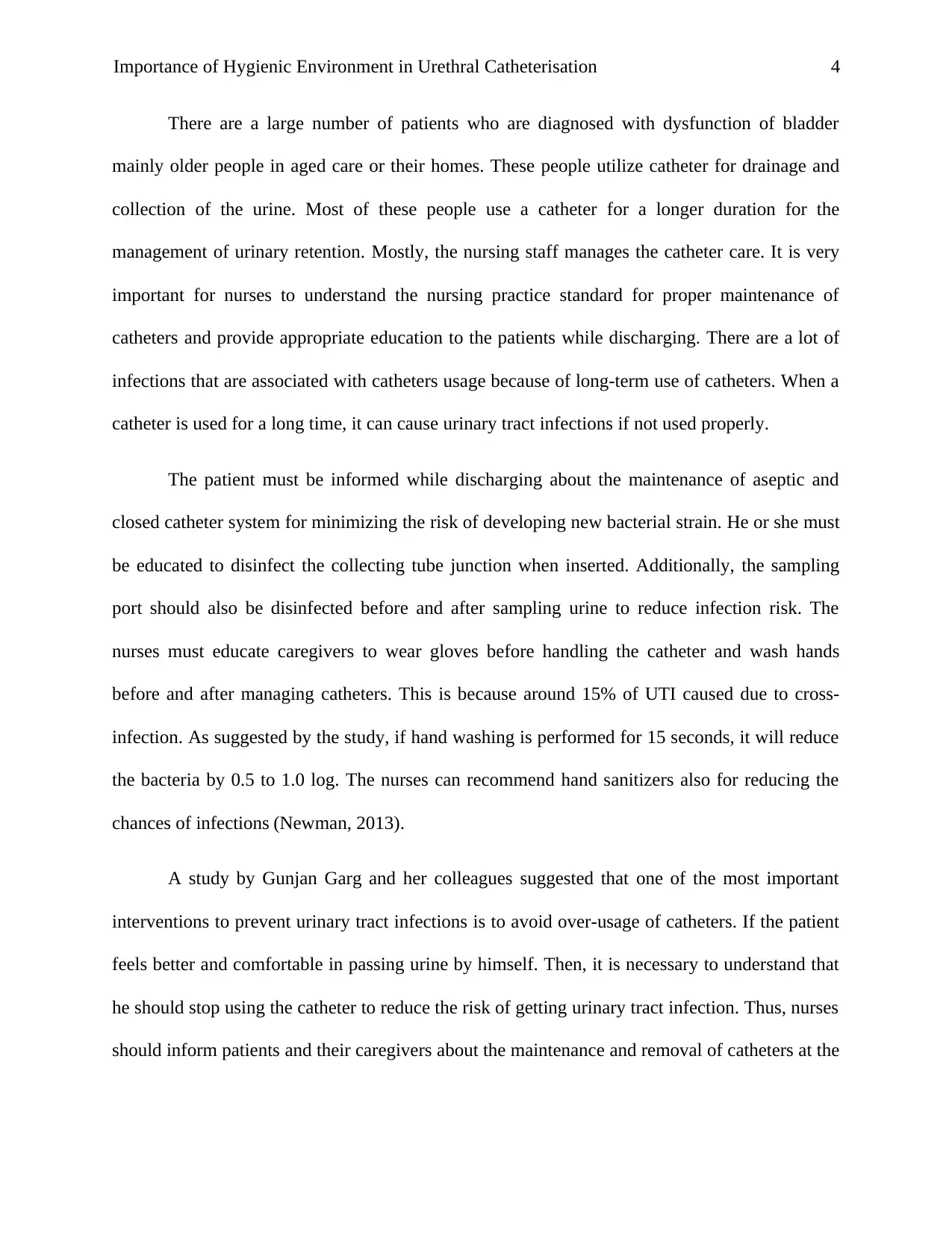
Importance of Hygienic Environment in Urethral Catheterisation 4
There are a large number of patients who are diagnosed with dysfunction of bladder
mainly older people in aged care or their homes. These people utilize catheter for drainage and
collection of the urine. Most of these people use a catheter for a longer duration for the
management of urinary retention. Mostly, the nursing staff manages the catheter care. It is very
important for nurses to understand the nursing practice standard for proper maintenance of
catheters and provide appropriate education to the patients while discharging. There are a lot of
infections that are associated with catheters usage because of long-term use of catheters. When a
catheter is used for a long time, it can cause urinary tract infections if not used properly.
The patient must be informed while discharging about the maintenance of aseptic and
closed catheter system for minimizing the risk of developing new bacterial strain. He or she must
be educated to disinfect the collecting tube junction when inserted. Additionally, the sampling
port should also be disinfected before and after sampling urine to reduce infection risk. The
nurses must educate caregivers to wear gloves before handling the catheter and wash hands
before and after managing catheters. This is because around 15% of UTI caused due to cross-
infection. As suggested by the study, if hand washing is performed for 15 seconds, it will reduce
the bacteria by 0.5 to 1.0 log. The nurses can recommend hand sanitizers also for reducing the
chances of infections (Newman, 2013).
A study by Gunjan Garg and her colleagues suggested that one of the most important
interventions to prevent urinary tract infections is to avoid over-usage of catheters. If the patient
feels better and comfortable in passing urine by himself. Then, it is necessary to understand that
he should stop using the catheter to reduce the risk of getting urinary tract infection. Thus, nurses
should inform patients and their caregivers about the maintenance and removal of catheters at the
There are a large number of patients who are diagnosed with dysfunction of bladder
mainly older people in aged care or their homes. These people utilize catheter for drainage and
collection of the urine. Most of these people use a catheter for a longer duration for the
management of urinary retention. Mostly, the nursing staff manages the catheter care. It is very
important for nurses to understand the nursing practice standard for proper maintenance of
catheters and provide appropriate education to the patients while discharging. There are a lot of
infections that are associated with catheters usage because of long-term use of catheters. When a
catheter is used for a long time, it can cause urinary tract infections if not used properly.
The patient must be informed while discharging about the maintenance of aseptic and
closed catheter system for minimizing the risk of developing new bacterial strain. He or she must
be educated to disinfect the collecting tube junction when inserted. Additionally, the sampling
port should also be disinfected before and after sampling urine to reduce infection risk. The
nurses must educate caregivers to wear gloves before handling the catheter and wash hands
before and after managing catheters. This is because around 15% of UTI caused due to cross-
infection. As suggested by the study, if hand washing is performed for 15 seconds, it will reduce
the bacteria by 0.5 to 1.0 log. The nurses can recommend hand sanitizers also for reducing the
chances of infections (Newman, 2013).
A study by Gunjan Garg and her colleagues suggested that one of the most important
interventions to prevent urinary tract infections is to avoid over-usage of catheters. If the patient
feels better and comfortable in passing urine by himself. Then, it is necessary to understand that
he should stop using the catheter to reduce the risk of getting urinary tract infection. Thus, nurses
should inform patients and their caregivers about the maintenance and removal of catheters at the
Secure Best Marks with AI Grader
Need help grading? Try our AI Grader for instant feedback on your assignments.
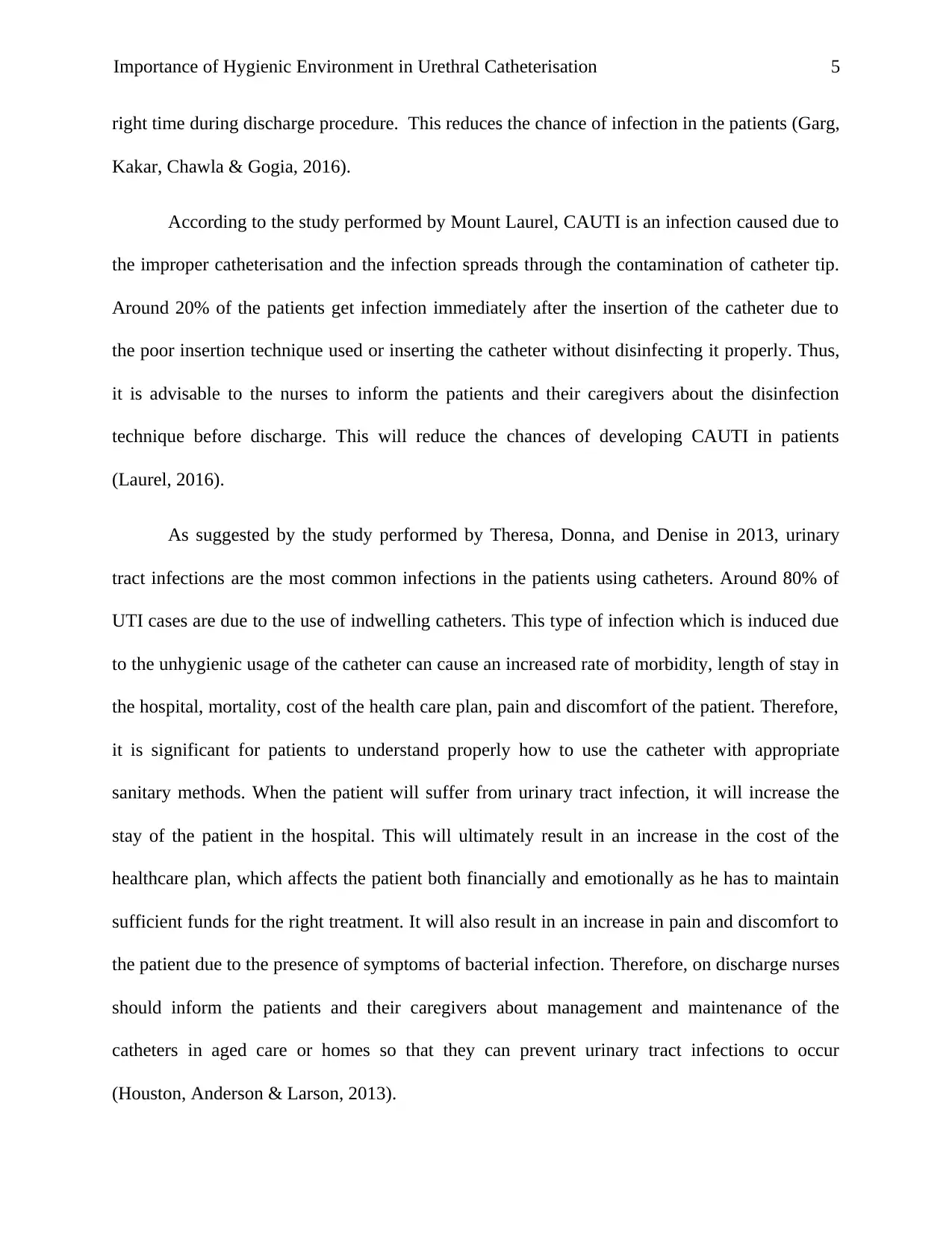
Importance of Hygienic Environment in Urethral Catheterisation 5
right time during discharge procedure. This reduces the chance of infection in the patients (Garg,
Kakar, Chawla & Gogia, 2016).
According to the study performed by Mount Laurel, CAUTI is an infection caused due to
the improper catheterisation and the infection spreads through the contamination of catheter tip.
Around 20% of the patients get infection immediately after the insertion of the catheter due to
the poor insertion technique used or inserting the catheter without disinfecting it properly. Thus,
it is advisable to the nurses to inform the patients and their caregivers about the disinfection
technique before discharge. This will reduce the chances of developing CAUTI in patients
(Laurel, 2016).
As suggested by the study performed by Theresa, Donna, and Denise in 2013, urinary
tract infections are the most common infections in the patients using catheters. Around 80% of
UTI cases are due to the use of indwelling catheters. This type of infection which is induced due
to the unhygienic usage of the catheter can cause an increased rate of morbidity, length of stay in
the hospital, mortality, cost of the health care plan, pain and discomfort of the patient. Therefore,
it is significant for patients to understand properly how to use the catheter with appropriate
sanitary methods. When the patient will suffer from urinary tract infection, it will increase the
stay of the patient in the hospital. This will ultimately result in an increase in the cost of the
healthcare plan, which affects the patient both financially and emotionally as he has to maintain
sufficient funds for the right treatment. It will also result in an increase in pain and discomfort to
the patient due to the presence of symptoms of bacterial infection. Therefore, on discharge nurses
should inform the patients and their caregivers about management and maintenance of the
catheters in aged care or homes so that they can prevent urinary tract infections to occur
(Houston, Anderson & Larson, 2013).
right time during discharge procedure. This reduces the chance of infection in the patients (Garg,
Kakar, Chawla & Gogia, 2016).
According to the study performed by Mount Laurel, CAUTI is an infection caused due to
the improper catheterisation and the infection spreads through the contamination of catheter tip.
Around 20% of the patients get infection immediately after the insertion of the catheter due to
the poor insertion technique used or inserting the catheter without disinfecting it properly. Thus,
it is advisable to the nurses to inform the patients and their caregivers about the disinfection
technique before discharge. This will reduce the chances of developing CAUTI in patients
(Laurel, 2016).
As suggested by the study performed by Theresa, Donna, and Denise in 2013, urinary
tract infections are the most common infections in the patients using catheters. Around 80% of
UTI cases are due to the use of indwelling catheters. This type of infection which is induced due
to the unhygienic usage of the catheter can cause an increased rate of morbidity, length of stay in
the hospital, mortality, cost of the health care plan, pain and discomfort of the patient. Therefore,
it is significant for patients to understand properly how to use the catheter with appropriate
sanitary methods. When the patient will suffer from urinary tract infection, it will increase the
stay of the patient in the hospital. This will ultimately result in an increase in the cost of the
healthcare plan, which affects the patient both financially and emotionally as he has to maintain
sufficient funds for the right treatment. It will also result in an increase in pain and discomfort to
the patient due to the presence of symptoms of bacterial infection. Therefore, on discharge nurses
should inform the patients and their caregivers about management and maintenance of the
catheters in aged care or homes so that they can prevent urinary tract infections to occur
(Houston, Anderson & Larson, 2013).
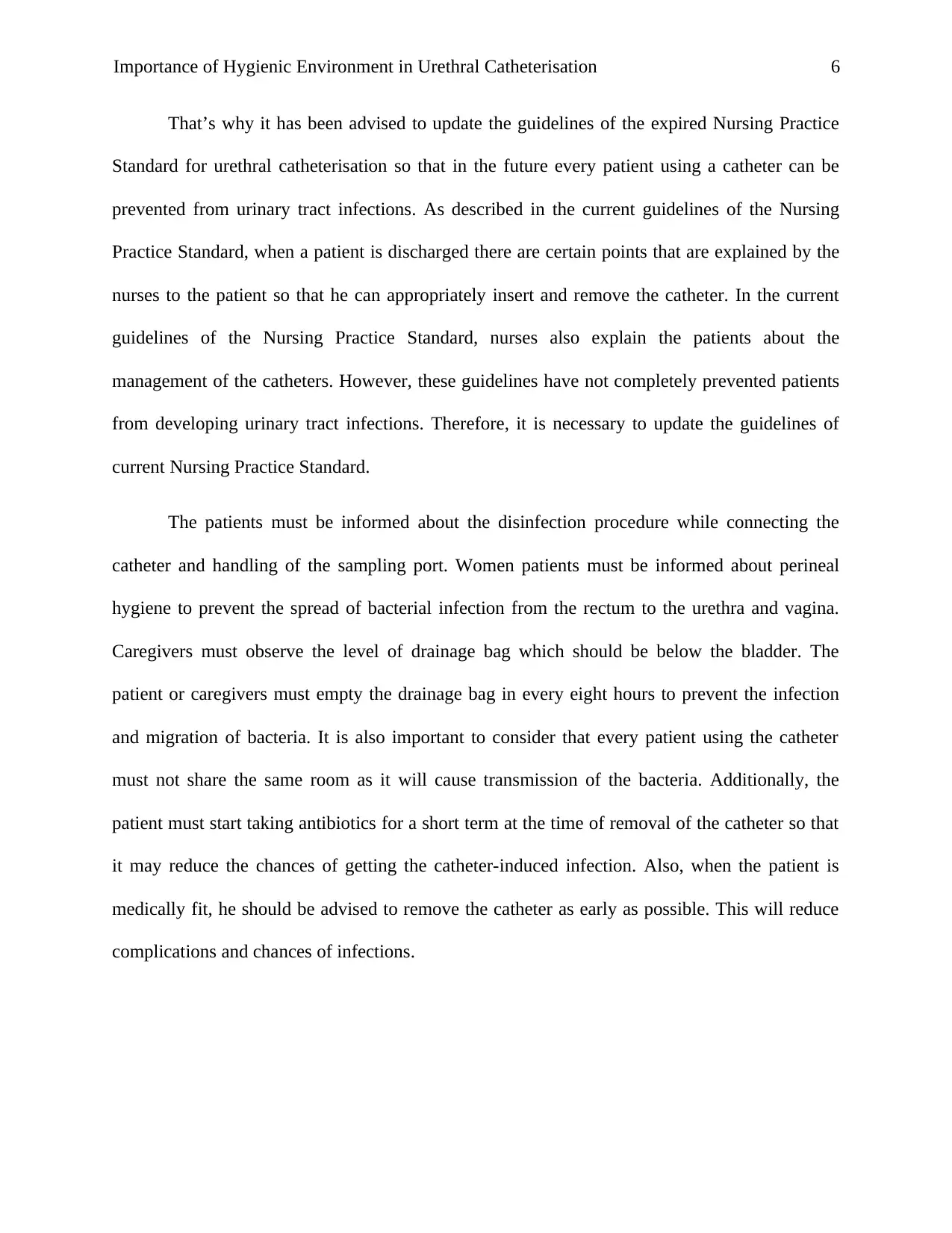
Importance of Hygienic Environment in Urethral Catheterisation 6
That’s why it has been advised to update the guidelines of the expired Nursing Practice
Standard for urethral catheterisation so that in the future every patient using a catheter can be
prevented from urinary tract infections. As described in the current guidelines of the Nursing
Practice Standard, when a patient is discharged there are certain points that are explained by the
nurses to the patient so that he can appropriately insert and remove the catheter. In the current
guidelines of the Nursing Practice Standard, nurses also explain the patients about the
management of the catheters. However, these guidelines have not completely prevented patients
from developing urinary tract infections. Therefore, it is necessary to update the guidelines of
current Nursing Practice Standard.
The patients must be informed about the disinfection procedure while connecting the
catheter and handling of the sampling port. Women patients must be informed about perineal
hygiene to prevent the spread of bacterial infection from the rectum to the urethra and vagina.
Caregivers must observe the level of drainage bag which should be below the bladder. The
patient or caregivers must empty the drainage bag in every eight hours to prevent the infection
and migration of bacteria. It is also important to consider that every patient using the catheter
must not share the same room as it will cause transmission of the bacteria. Additionally, the
patient must start taking antibiotics for a short term at the time of removal of the catheter so that
it may reduce the chances of getting the catheter-induced infection. Also, when the patient is
medically fit, he should be advised to remove the catheter as early as possible. This will reduce
complications and chances of infections.
That’s why it has been advised to update the guidelines of the expired Nursing Practice
Standard for urethral catheterisation so that in the future every patient using a catheter can be
prevented from urinary tract infections. As described in the current guidelines of the Nursing
Practice Standard, when a patient is discharged there are certain points that are explained by the
nurses to the patient so that he can appropriately insert and remove the catheter. In the current
guidelines of the Nursing Practice Standard, nurses also explain the patients about the
management of the catheters. However, these guidelines have not completely prevented patients
from developing urinary tract infections. Therefore, it is necessary to update the guidelines of
current Nursing Practice Standard.
The patients must be informed about the disinfection procedure while connecting the
catheter and handling of the sampling port. Women patients must be informed about perineal
hygiene to prevent the spread of bacterial infection from the rectum to the urethra and vagina.
Caregivers must observe the level of drainage bag which should be below the bladder. The
patient or caregivers must empty the drainage bag in every eight hours to prevent the infection
and migration of bacteria. It is also important to consider that every patient using the catheter
must not share the same room as it will cause transmission of the bacteria. Additionally, the
patient must start taking antibiotics for a short term at the time of removal of the catheter so that
it may reduce the chances of getting the catheter-induced infection. Also, when the patient is
medically fit, he should be advised to remove the catheter as early as possible. This will reduce
complications and chances of infections.
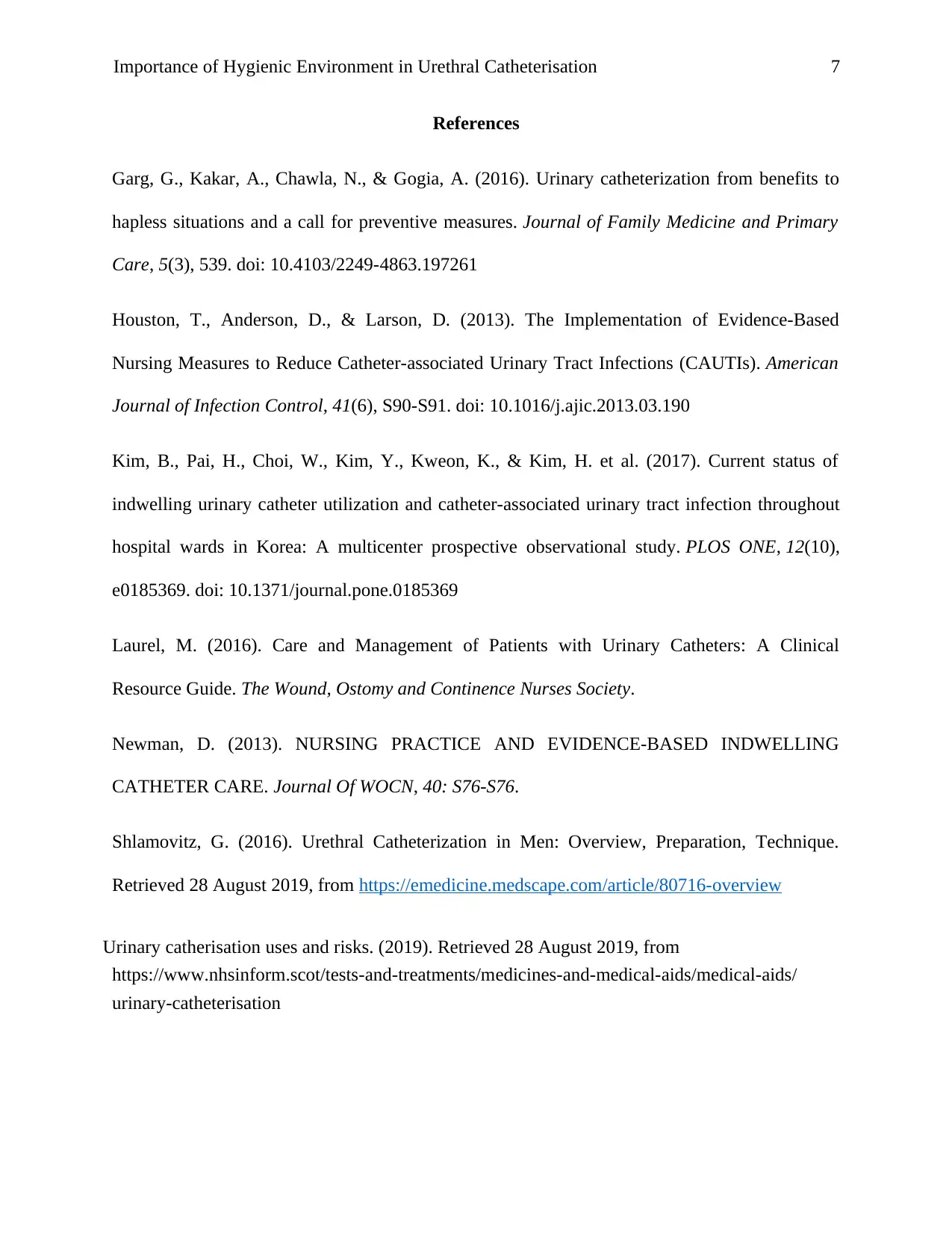
Importance of Hygienic Environment in Urethral Catheterisation 7
References
Garg, G., Kakar, A., Chawla, N., & Gogia, A. (2016). Urinary catheterization from benefits to
hapless situations and a call for preventive measures. Journal of Family Medicine and Primary
Care, 5(3), 539. doi: 10.4103/2249-4863.197261
Houston, T., Anderson, D., & Larson, D. (2013). The Implementation of Evidence-Based
Nursing Measures to Reduce Catheter-associated Urinary Tract Infections (CAUTIs). American
Journal of Infection Control, 41(6), S90-S91. doi: 10.1016/j.ajic.2013.03.190
Kim, B., Pai, H., Choi, W., Kim, Y., Kweon, K., & Kim, H. et al. (2017). Current status of
indwelling urinary catheter utilization and catheter-associated urinary tract infection throughout
hospital wards in Korea: A multicenter prospective observational study. PLOS ONE, 12(10),
e0185369. doi: 10.1371/journal.pone.0185369
Laurel, M. (2016). Care and Management of Patients with Urinary Catheters: A Clinical
Resource Guide. The Wound, Ostomy and Continence Nurses Society.
Newman, D. (2013). NURSING PRACTICE AND EVIDENCE-BASED INDWELLING
CATHETER CARE. Journal Of WOCN, 40: S76-S76.
Shlamovitz, G. (2016). Urethral Catheterization in Men: Overview, Preparation, Technique.
Retrieved 28 August 2019, from https://emedicine.medscape.com/article/80716-overview
Urinary catherisation uses and risks. (2019). Retrieved 28 August 2019, from
https://www.nhsinform.scot/tests-and-treatments/medicines-and-medical-aids/medical-aids/
urinary-catheterisation
References
Garg, G., Kakar, A., Chawla, N., & Gogia, A. (2016). Urinary catheterization from benefits to
hapless situations and a call for preventive measures. Journal of Family Medicine and Primary
Care, 5(3), 539. doi: 10.4103/2249-4863.197261
Houston, T., Anderson, D., & Larson, D. (2013). The Implementation of Evidence-Based
Nursing Measures to Reduce Catheter-associated Urinary Tract Infections (CAUTIs). American
Journal of Infection Control, 41(6), S90-S91. doi: 10.1016/j.ajic.2013.03.190
Kim, B., Pai, H., Choi, W., Kim, Y., Kweon, K., & Kim, H. et al. (2017). Current status of
indwelling urinary catheter utilization and catheter-associated urinary tract infection throughout
hospital wards in Korea: A multicenter prospective observational study. PLOS ONE, 12(10),
e0185369. doi: 10.1371/journal.pone.0185369
Laurel, M. (2016). Care and Management of Patients with Urinary Catheters: A Clinical
Resource Guide. The Wound, Ostomy and Continence Nurses Society.
Newman, D. (2013). NURSING PRACTICE AND EVIDENCE-BASED INDWELLING
CATHETER CARE. Journal Of WOCN, 40: S76-S76.
Shlamovitz, G. (2016). Urethral Catheterization in Men: Overview, Preparation, Technique.
Retrieved 28 August 2019, from https://emedicine.medscape.com/article/80716-overview
Urinary catherisation uses and risks. (2019). Retrieved 28 August 2019, from
https://www.nhsinform.scot/tests-and-treatments/medicines-and-medical-aids/medical-aids/
urinary-catheterisation
1 out of 7
Related Documents
Your All-in-One AI-Powered Toolkit for Academic Success.
+13062052269
info@desklib.com
Available 24*7 on WhatsApp / Email
![[object Object]](/_next/static/media/star-bottom.7253800d.svg)
Unlock your academic potential
© 2024 | Zucol Services PVT LTD | All rights reserved.





